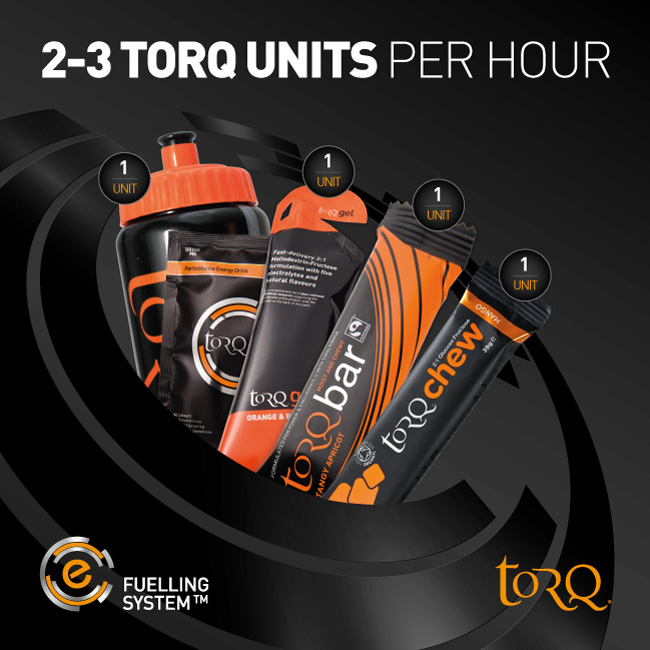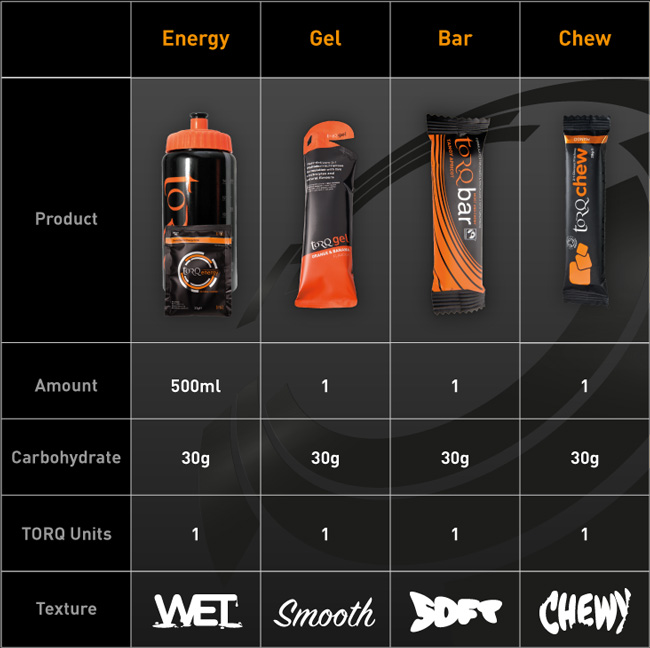Science
What is Superior Energy?
Let’s breakdown carbs and sugars…
At TORQ, we formulate our products with precision and are constantly rooting through the latest research to ensure that no stone is left unturned with regard to functionality. TORQ has an unrivaled reputation for delivering clean, natural products, free from artificial ingredients.

It is our firm conviction that there is not a single ingredient derived from an artificial source (that couldn’t also be sourced naturally) which could be attributed to better performance in an athlete – with the exception of some on the WADA banned substances list of course! It is also our deep and strong philosophy that many artificial ingredients will actually interfere with performance, because the human body is not designed to deal with them. This is one of the reasons why TORQ has such a solid reputation for not using artificial sweeteners. We also don’t use colors, not even natural ones, because under exercise stress, the digestive system is under significant strain, so why make the process harder by including unnecessary ingredients? If you’re going to add a color to a food, of course we think it should be a natural one, but the first question we ask ourselves is ‘does this ingredient need to be in there’? If the answer’s ‘no’, we leave it out. Period.
The Science of our Products
Torq energy (fueling) products use a blend of two types of carbohydrate combined together (known as multi-transportable carbohydrates):
1) Fructose (fruit sugar essentially)
2) Maltodextrin (a long-chain glucose derivative made from maize)
Combining these two natural ingredients in the correct ratios delivers energy significantly better (about 40%) than using solely glucose based products (of which there are many in the market today). Glucose comes hidden in many forms, namely glucose (of course), maltodextrin, dextrose, and it’s hidden in sucrose.
The Constraint of single-form Carbohydrates
The maximum oxidation rate of carbohydrate is around 1gram of carbohydrate per minute (60grams of carbohydrate per hour) when using a single form of carbohydrate, such as maltodextrin or glucose. This is limited by the speed at which a single form of carbohydrate could be absorbed by the body. Once the intestinal transporter that absorbs the carbohydrate from the intestine, driving it into the blood, becomes saturated, any additional carbohydrate simply ends up sitting on the stomach. This is the last thing you want when exercising as this can/will result in gastrointestinal upset (i.e. ‘gut rot’). However more recently a growing body of research has suggested greater oxidation rates of carbohydrate are possible if glucose derivatives and fructose are mixed.
2:1 Maltodextrin + Fructose
Here’s a summary of why combining Maltodextrin with Fructose at 2:1 is so effective:
Why are TORQ’s multiple-transportable carbohydrate (2:1 Glucose-Derivatives:Fructose) formulations so much more effective than those produced using a traditional single carbohydrate source?
Carbohydrate is the critical fuel source during intense exercise and is essential during bouts of endurance training and competition. The more carbohydrate that is oxidized (burnt) the better your performance, as demonstrated by a mountain of peer reviewed independent research studies. The body has a very limited endogenous supply of carbohydrate, stored in the muscles and liver, and when fully topped up, it equates to around 2000kcal (500grams of carbohydrate). This is a relatively limited pool of carbohydrate and during high intensity exercise it can be completely depleted in as little as an hour. This combined with a limited capacity to absorb carbohydrate into the blood stream in the intestine means that as an endurance athlete competing or training for more than a couple of hours, you are essentially fighting a losing battle. No matter how well you are able to fuel with carbohydrate, you will eventually run out, particularly when performing endurance exercise longer than a couple of hours in duration. As a result, the more carbohydrate that can be absorbed during exercise, the greater the oxidation rate (burning) of exogenous carbohydrate, which reduces the reliance on the body’s endogenous stores. This results in a performance improvement by delaying the dreaded ‘bonk’ and subsequent catastrophic drop in performance!
For a number of years the maximum oxidation rate of exogenous carbohydrate was thought to be around 1gram of carbohydrate per minute (60grams of carbohydrate per hour) when using a single form of carbohydrate, such as maltodextrin or glucose. This was limited by the speed at which a single form of carbohydrate could be absorbed by the body. Once the intestinal transporter that absorbs the carbohydrate from the intestine (SGLT1), driving it into the blood becomes saturated, any additional carbohydrate simply ends up sat on the stomach, which is the last thing you want when exercising, since this can result in gastrointestinal upset. However more recently a growing body of research has suggested greater oxidation rates of carbohydrate are possible if glucose derivatives and fructose are mixed. The animation below shows how transportation of glucose derivatives from intestine to blood (via SGLT1) is limited to 60grams per hour. Play the short video below a couple of times over to fully understand the concept.
A study by Wallis et al. in 2005 (as quoted on our gel pack) turned conventional wisdom on its head and sparked a change in the recommendations for fueling during endurance exercise. Wallis and his research group showed that by combining maltodextrin (glucose) with fructose at a 2:1 ratio, carbohydrate oxidation rates increased by a massive 40% and allowed up to 90grams of carbohydrate to be absorbed into the system! This was due to fructose and maltodextrin using different intestinal transporters (Fructose uses the GLUT5 transporter), which meant that the two carbohydrates could be absorbed independently of each other, allowing a faster absorption and a higher oxidation rate of carbohydrate. The study had massive implications as a 40% increase in exogenous carbohydrate oxidization would naturally have a big impact on performance by reducing reliance on the body’s limited endogenous stores. Since the study by Wallis et al (2005) there has been a great deal of further research into the use of multiple transportable carbohydrates (i.e. maltodextrin and fructose) and a number of significant benefits to using this formulation have come to light. The animation below demonstrates how the GLUT5 transporter draws fructose through the intestinal wall independently of glucose absorption, resulting in the delivery of a significant 90grams total carbohydrate per hour. Once again, play the video below a couple of times to fully understand the concept.
Currell and Jeukendrup (2008) completed one of the first studies which looked directly at the effect of a glucose:fructose, 2:1 beverage on performance. Using a simulated 1-hour time trial in the lab, after 120 minutes of cycling exercise at 55% of their VO2max (maximal oxygen consumption), participants consumed either a placebo (flavored water), glucose or a glucose:fructose drink. The results of the study were simply astounding. Performance improved by 8% as a result of using the 2:1 glucose:fructose drink, which was on top of a 10% improvement in performance from taking on glucose alone! Similarly Triplett et al. 2010 also showed an 8.1% performance improvement due to a higher power output when using glucose:fructose drink during a simulated 100km cycling time trial. Interestingly Triplett did not measure gastrointestinal upset directly, but did report that participants on the glucose:fructose experienced no problems at all whilst many of his participants in the glucose only trial reported problems with their stomachs ‘not emptying the solution’. More recently Rowlands et al. (2012) studied the use of maltodextrin:fructose in a more practical application, using a 2h 30min mountain bike race and high intensity cycling lab test. The results also showed a significant improvement in performance in both the lab and field, with one of the most interesting findings of the study being a significant reduction in gastrointestinal upset as a result of using a maltodextrin:fructose solution.

With Rowland’s et al. (2012) reporting a significant reduction in GI upset as a result of using multiple transportable carbohydrates both in the lab and in the field, these findings suggest that the carbohydrate solution which participants were taking on during the study was being emptied from the stomach faster and caused less GI distress as a result of the addition of fructose. An earlier study by Jeukendrup and Moseley (2008) looked at the effect of adding fructose to glucose on gastric emptying speed during a 120min cycling bout at 61% of the participant’s VO2max. Results from the study suggested that using glucose:fructose increased the rates of gastric emptying and fluid delivery compared with glucose alone. This has quite significant practical implications as they reported faster gastric emptying would result in a faster delivery of water, aiding hydration and a reduced occurrence of stomach upset during exercise.
It is important to point out that, in order to experience the benefits of using multiple transportable carbohydrates over that of a single form of carbohydrate, you need to saturate the transporters in the intestine that absorb the carbohydrate as comprehensively as possible, so to experience the benefits, an intake of 90grams of carbohydrate per hour is recommended. Taking on board only 60 grams per hour will supply a good level of carbohydrate to the blood with an extremely low chance of any gastrointestinal discomfort, but the higher doses are where the true benefits of maltodextrin:fructose lie over single carbohydrate forms.

Further to this, a recent review by Jeukendrup (2010) has shown that carbohydrate oxidisation is not related to body weight so an intake of 90grams of carbohydrate per hour can be achievable regardless of body size. This is quite a large volume of carbohydrate and in order to achieve these sorts of intakes during competition to maximise performance, it is beneficial to practice during training. There is evidence that the gut is a trainable organ, so to ensure you can cope with the high carbohydrate intake it’s important to practice your fuelling strategy during training as this will ensure come race day you can be confident that you can take sufficient amounts on board.
A carbohydrate intake of up to 90grams per hour in the form of 2:1 Glucose-Derivatives:Fructose will aid your performance, reduce the occurrence of stomach upset, speed up the delivery of water and rapidly increase the rate at which carbohydrate can be replenished after exercise. However, it is important to point out that you will only get optimal benefits through taking in the full 90grams of carbohydrate an hour and in order to comfortably achieve this intake, it may require some practice so that the gut gets used to these high volumes. As other non Glucose-Derivatives:Fructose products will only allow 60g of carbohydrate absorption per hour, you are losing nothing by starting at this level though (2 TORQ units per hour) and the nature of the multiple-transportable carbohydrate cocktail will be very light on the stomach due to it being significantly below your absorption threshold. You literally have everything to gain from using TORQ’s formulations. We recommend that you start at 2 TORQ units per hour and train yourself up to 3.
Finally, we cover this area in more detail on our page explaining the TORQ Recovery System, but it’s appropriate to mention here how the inclusion of glucose-derivatives and fructose post-exercise is important. As an athlete undertaking repeated bouts of training or competition, the speed at which your endogenous stores of carbohydrate can be replenished after exercise can have a significant impact on your subsequent race performance or training session, so the quicker and more substantially these stores can be replenished, the better the performance in the next exercise bout. One of the major limiting factors in the restoration of these carbohydrate stores is the speed of absorption of carbohydrate (Jentjens and Jeukendrup, 2003) which is significantly increased by the use of maltodextrin:fructose.
Recent studies by Wallis et al. 2008 looked at the effect of combined glucose and fructose ingestion on short term recovery of muscle glycogen after exercise. The result of the study showed that both glucose and glucose:fructose elicited similar rates of resynthesis but, didn’t see any detriment to recovery through the use of fructose and reported resynthesis rates comparable with the highest previously reported. More recently Decombaz et al. (2011) looked at the effect of malotdextrin:fructose on liver glycogen synthesis, the body’s other major store of carbohydrate, which appears to be replenished before muscle glycogen is. The results showed a massive doubling of carbohydrate storage in the liver through the addition of fructose! This is particularly significant as a reduction in the time taken to replenish the body’s stores of carbohydrate could massively aid subsequent performance or training.
Now...we've instilled you with much knowledge. Become even more powerful by checking out our TORQ Fueling System, an easy way to understand (and remember) how to plan your nutrition based on intensity and environment! Click HERE.
